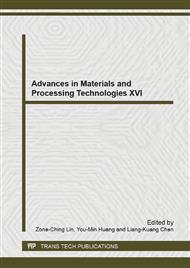p.60
p.68
p.76
p.84
p.90
p.98
p.106
p.114
p.122
Tensile Properties and Microstructure of Joined Vacuum Die Cast Aluminum Alloy A356 (T6) and Wrought Alloy 6061
Abstract:
In the present work, fusion-joining of vacuum high pressure die cast (HPDC) aluminum alloy A356 and wrought alloy 6061 by applying Gas Metal Arc Welding (GMAW-MIG) process was investigated to understand the effect of the MIG process on the microstructure and tensile behaviors of the base joined alloys (T6 Heat treatment A356 and 6061). The microstructures of the base metal (T6 heat treatment A356 and 6061), Heat Affected Zone (HAZ) and Fusion Zone (filler metal ER4043) were analyzed by Scanning Electron Microscopy (SEM) and optical microscopy. The results of tensile testing indicated that, the ultimate tensile strength (UTS) and yield strength (YS) of V-HPDC alluminium A356 subjected to T6 thermal treatment were relatively low, compared to both wrought alloy 6061 and the filler metal (ER 4043). The microstructure analysis showed that the low strengths of T6 A356 alloy should be at least attributed to the absence of the magnesium-based intermetallic phase, coarse grain structure and the presence of porosity, which resulted from the HPDC process, MIG welding and thermal treatment.
Info:
Periodical:
Pages:
90-97
Citation:
Online since:
May 2014
Authors:
Price:
Сopyright:
© 2014 Trans Tech Publications Ltd. All Rights Reserved
Share:
Citation:


